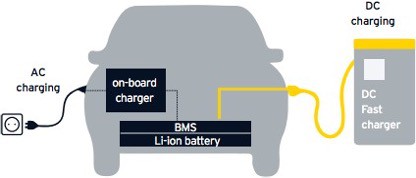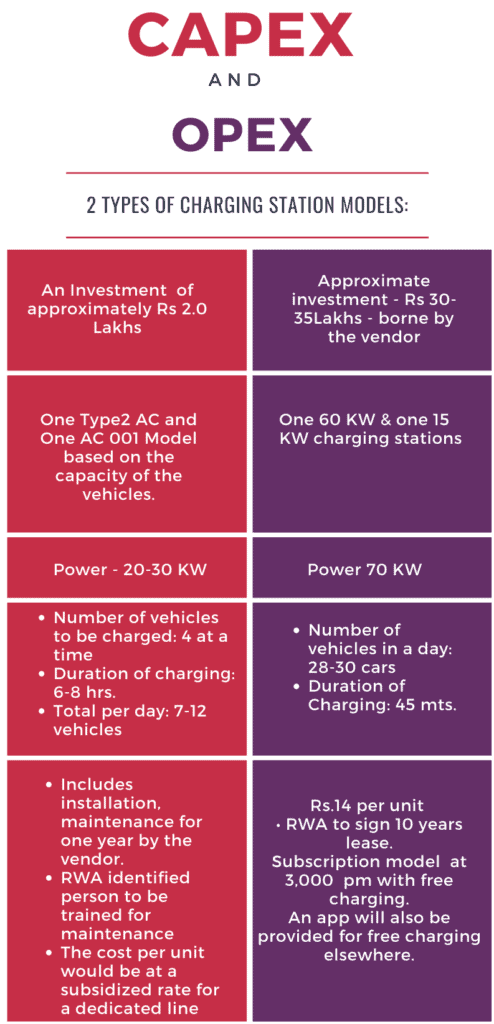Petrol and diesel prices in Bengaluru stand at Rs 105 and Rs 95 respectively. The increasing prices have hit the transport expenses of lower and middle-income Bengalureans. Looking for lower operating costs, they are increasingly choosing electric vehicles (EV). As the adoption of e-vehicles increases, so does the need for infrastructure to support it.
An internal survey by Bangalore Apartment Federation predicts a 5-6% increase in EV adoption amongst its members. This, in turn, necessitates Apartment Associations to anticipate, plan and expand the charging infrastructure to accommodate increasing numbers of e-vehicles amongst their residents. Apartments are setting up community charging stations where several vehicles can be charged simultaneously in one location.
Read more: Delhi electric vehicle policy: Ambitious targets, but is the capital ready?
Electric Vehicle Charging Station Infrastructure
An Electric Vehicle Charging Station, also called EV Charging Station or Electronic Charging Station (ECS) supplies electric energy for the recharging of plug-in electric vehicles—including electric cars and electric two-wheelers.
The Electric Vehicle Supply Equipment (EVSE) enhances safety by enabling two-way communication between the charging station and the electric vehicle. EVSEs have a safety lock-out feature that does not allow current to flow from the device until the plug is physically inserted into the vehicle.
Automotive Research Association of India (ARAI) recommends using EVSEs to charge any EV safely as compared to using a simple 15A/240V socket, which is the normal practice in vogue at present, which fails to cover the aspect of safety.
The EVSE is usually a wall-mounted box, or a small cement structure that supplies electric energy to the onboard charger for the recharging of electric vehicle batteries.

Implementing an Electric Vehicle Charging Station
Step 1: Identify how many charging points and what type of charging points you need:
- Conduct an online poll or some other means to understand how many people would require and what type of charging points are required. Example: 10 bike charging points and 5 car charging points.
- Next identify if you need fast DC charging points or slow AC charging points.
- Decide if you’d want to allow outsiders to use the charging stations or not (on a commercial basis)
Step 2: Call a few vendors to get quotations and proposals:
- Identify if you need an additional new connection or transformer to support this additional electrical load.
- Evaluate between Capex and Opex models.

Step 3: Get an LT6 electrical connection
Apply for a BESCOM connection under LT6 – a Low Tension category specifically for EV Charging.
Step 4: Work with the vendor to complete the installation
The installation is relatively simpler and takes only 1-2 months to complete. Identity the right vendor with enough expertise and complete the installation.
The cost of the installation completely depends on the following factors:
- No. of charge points
- Type of charger
- Length of the cable
- Additional transformer yard requirement (if necessary)
Depending upon the type of charger and KW capacity of the connection, the speed of charging is determined.
Types of Charging Stations
| AC charging | DC charging |
|---|---|
| Low cost and easy installation | Speed of charging is almost 6-7 times faster |
| AC chargers take lower power like 3.3 kW and 7.4 kW per charger | Better suited for faster revenue generation and more cars can be charged with fewer charging points |
| You can charge more vehicles with lesser sanctioned loads | Disadvantage of fast DC chargers: DC chargers take 15 KW and higher load. An apartment needs to have a much higher sanctioned load capacity to support more DC vehicle charging. |
Benefits of setting up an electric vehicle charging infrastructure
To promote faster adoption of EVs in the state of Karnataka, KERC has provided a new introductory Tariff schedule for Electric Vehicle Charging Stations under LT6 (C) category.
Here are the tariff details for FY 20-21 applicable for BESCOM customers.
Approved Tariff for LT2(a) – Regular domestic connection)
- Fixed/Demand Charges: Rs.95/ kW/Month
- Energy Charges: net 888 paise/KWh unit
Approved Tariff for LT6(c):
- Fixed/Demand Charges: Rs70/kW/month upto 50 kW and Rs 170/kW/month for every additional 50 kW
- Energy Charges: net 500 paise/kWh unit
The advantages of applying a new LT6 connection (and meter) vs. using the existing connection are:
- LT6 has a subsidised tariff of Rs 5.45 per unit. Fixed tariff charges also need to factor in the fact that if you use your existing connection, then you end up paying Rs. 8-9 per unit.
- A dedicated connection provides a more stable electricity supply.
- You need to check your apartment sanctioned load and see if that can support the charging stations.
- For an initial pilot setup, an apartment can go with existing connection as there are no additional charges to be borne by the association for LT6 connection. Later on, they can invest on the new LT6 connection depending on the RoI on the project.
Of course, there are some other costs that need to be kept in mind, like deposit per KW of new load, monthly fixed charges on the new meter/connection, etc.
Read more: Mitigating the curse of the car in Indian cities
Economic benefits of electric vehicles
Electric vehicles are convenient from multiple perspectives:
- No RTO/RTA registration costs for the vehicle
- Running/maintenance costs of the vehicle are very less
- Fuel cost of charging in comparison with petrol/diesel is very cheap
Example: It may require 30 units (kWh) to charge a Tata Nexon car. The apartment buys electricity at Rs 5.50 to apartments under LT6 connection. Suppose the apartment charges the car owner at Rs 10 per unit:
- The EV owner ends up paying Rs 300 for a full charge of the vehicle.
- Let’s assume that (in the worst case) Tata nexon runs 200 km in full charge in city conditions.
- The owner ends up paying Rs 1.50 per km.
Compared to this, the running cost of a petrol or diesel vehicle would be more.
Environment benefits of electric vehicles
- Zero direct air pollution from electric vehicles and significantly improves the city air quality. There is also no noise pollution.
- EVs approximately have 35% less CO2 indirect emissions compared to a similar-sized petrol car. Indirect emissions refer to the CO2 emitted in the process of making the car and its components and also extracting the raw materials required to make the cars.
It is true the source of electricity that we use to charge EV could be from a coal-powered source for now. However, there is a slow but steady shift towards cleaner energy generation technologies.
FAQs
This is not advisable or recommended. This can lead to fire accidents and electricity load issues.
No. But that gives economic benefits with lower tariffs.
Yes, you can. There is a capital investment cost involved to set up charge stations and that can be recovered
Very nice! Wasn’t aware of all the benefits from govt. I’m hoping there will be more encouragement in coming days from govt. With more EV options in market, it may finally take off like it should.
Question: Will the recently announced benefit from scrapping old vehicles make the deals even sweeter for the people still holding onto their old cars?
Thanks for very informative article. Would you please suggest some national vendors for setting up charging infrastructure.
You can contact ecosoch, magenta, EV motors etc.
Tata power is in discussions with BAF
very clear explanation. thanks for the input!!
How about putting up solar panels for charging the EVs?
This will require the EV owner to keep shifting his vehicle back & forth between the charging station and his individual parking slot. Why put him to such inconvenience when it’s much simpler to have the charging point in his parking slot itself? I can’t understand the logic of it all, more so when much needed ground space in the complex will now be taken up by this activity. Apart from all of that will be the GST complications arising from the pricing differentials. Not at all a sound proposition
Against FAQ1, it is stated “Can the owners not directly draw electricity from their meters?”
Ans: “This is not advisable or recommended. This can lead to fire accidents and electricity load issues”. This I wish to submit is mis-information. Bescom is readily allowing and encouraging it too. The lower LT-6 tariff is being extended to it too.